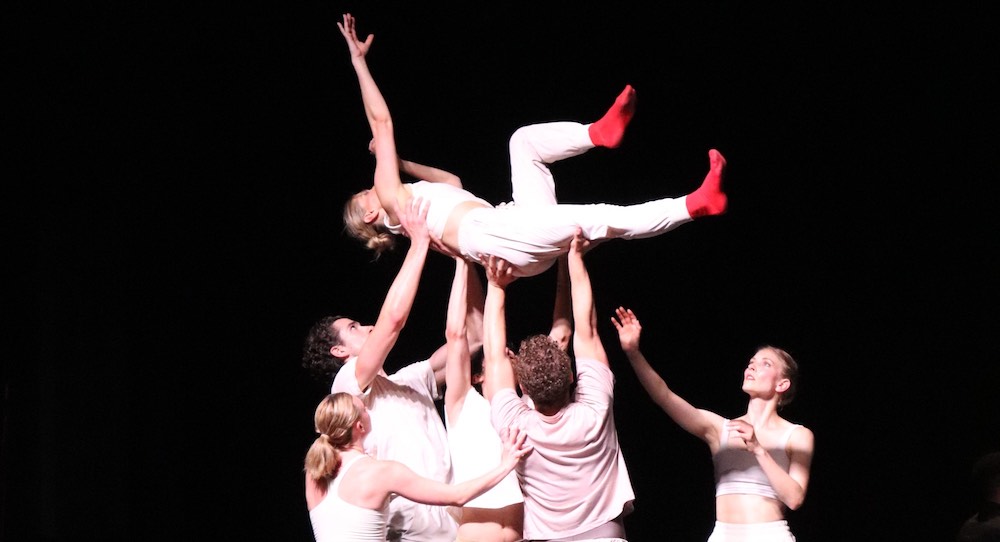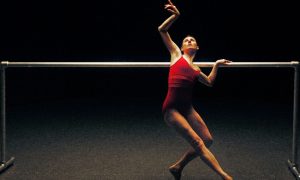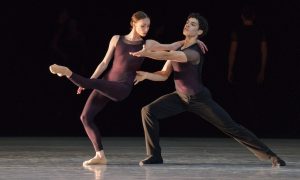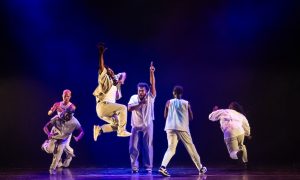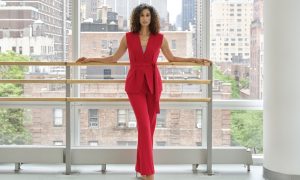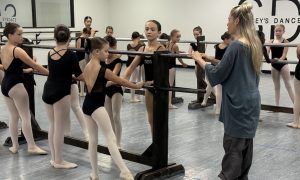The Strand Ballroom and Theater, Providence, RI.
June 29, 2025.
There’s just something about the way music and movement come together: a shape meeting the tone of a note, an accent hitting a rhythm just so, a limb extending as a chord resonates. Revolve Dance Project specializes in exploring this intersection.
The company’s fourth annual program, Sound in Form, demonstrated a deepening and refining of that connection. The included works conferred varied atmospheres and approaches, yes, yet each breathed with that special harmony of sound and motion meeting…sound in form indeed! The magic of music and movement breathing together didn’t stop flowing from the stage and gracing us in the audience.
The program opened with Danielle Diniz’s vibrant and enticing Revolutions, with music composition from Anthony Hervey. Quick steps aligned with jazzy drum beats. The movement was quite balletic in form, yet also oozed with sass and panache: rolling hips, sure footwork, sly smiles accompanying quick turns. The work thus felt akin with Balanchine works that also explored this territory.
Just as Balanchine also did, Diniz constructed spacing and structure to work well with this being a trio (danced by Kailee Felix, Kirsten MacIntosh and Katie Vigly). Overall, after only a few minutes, it had me feeling viscerally reminded of how magical concert dance can be — when the alchemy of music, movement and design gel just so. The work also epitomized short and sweet, a little nugget that offered a whole feast of vibrancy and kinetic energy.
Luis Ocaranza’s Not So Obvious Love, with score from Katie Martucci, maintained that delicious alchemy. Aram Hengen, with both fluid and impassioned energy to his movement, embodied the feel of the score: jazzy rock with just a touch of indie cool. Kailee Felix joined him for a pas de deux soothing in its ease, the connection between them beautifully unforced. Felix, for her part, was soft yet tenacious in the textures of each count and step. It was another delectable bite of, yes, sound in form.
Lauren Lovette’s Bones/Phalanges brought another rich and meaningful pas de deux, but of a new tone: dogged, fiery, assertive. Cameron MacIntosh’s pounding drum beats (score composed by MacIntosh and Daniel Hass) met the dancers’ lightning accents. Duet partners Kirsten MacIntosh and Ocaranza came together and apart, magnets attracting and repelling. MacIntosh had a lovely way of letting her length through shifting shape and line do its work – nothing at all to prove.
A bit more mystery, even angst, came into the ether with lights dimming and physical energy easing. Yet, their ferocity remained. The partners, as personae, also seemed to find more moving harmony – true tangible connection – as the work progressed into a close. That felt like quite a satisfying way to end their wordless story.
Jeffrey Cirio’s She Who Sinks was an enigmatic, and equally compelling, solo danced by Katie Vigly. Her aqueous spine and elusive gestures traversed the score’s tones and textures (score composed and played live by Josh Knowles) – and her theatricality was just as masterful.
The abstraction at hand made it such that I wasn’t quite sure of the exact nature nor source of her pathos – yet it felt honest enough to have me fully invested. The mystery of it all, as well as its pure energetic and visual beauty, pulled me right in. Vigly ended the work in the same angular and unconventional shape she started; the pathos and enigma cycle, just as all things do.
Emily Adams’ Past Lives, with score also composed by Knowles, brought us back to a softer, more contemplative atmosphere. The movement quality was languid and unhurried, gorgeously so, even when the speed escalated. As in prior works, the respective textures of the score and movement harmoniously met, smoothly folding like stirred batter. Notes melted just as spines did, shape to shape.
The work was functionally a duet, yet a few different ballerinas partnered Joe Lynch – thus creating a few various pairings, each with its own particular feel and flavor. These comings and goings felt fluid and natural, just as it ideally is when people inevitably come and go from our lives.
Dara Capley’s Bandage and a Wound presented something with a touch of narrative, but also alluring abstraction; there was just enough theatrical clarity to keep me guessing and wanting more. It began with Vigly’s persona setting up a table, eliciting cheers from the audience when she finished the job (how heartwarming!). She began moving, gestures emanating feeling – the live singer’s voice doing that just as much (score by Katie Martucci). Once again, I didn’t know where her pathos came from, but I believed it – because it was honest.
The work moved into various solos, duets and ensemble sections: a structure that embodied connections and disconnections, the individual but also shared joys and sorrows, within a community. Later, they settled into a tableau back around the table, gestures to each other assured but also caring.
Further group sections of heightened energy, with the same fresh shaping of movement and stirring performance, continued from there. The work likely could have ended around the table and felt complete – yet what happened after that was pleasing enough that I had no complaints…negative complaints, really.
Laine Habony’s highly evocative Weight of the World, with score composed by Katie Jenkins, got us back to duets. This one had a mood just as unique as those of prior works, with red and black costuming, as well as minor chords in the music bringing a subtly chilling feel. Yet the duet partners shared a tenderness that warmed the chill. Movement was largely balletic, with a certain bravado and stateliness. Their individual qualities came together cohesively to create that feeling, just as all aesthetic flavors in the work did.
Kurt Douglas’ invigorating Runner’s High, another larger group work, closed the program. It also had a touch of delightful quirkiness, such as with red socks juxtaposing white costumes. Partnering mixed and melded with jazzy beats in the score (by Daniel Hass). Speedy movement shifted into much slower phrasing, offering an appealing rhythmic variance.
The slower shapes reflected those of a runner – slight lunge, elbows bent with one forward of the other – and the tempo variance how runners intentionally quicken and slow their pace as they train. As with the program overall, inventive shaping and pathways of movement kept me locked into the onstage action.
Even more importantly, one could argue, joyful energy just burst from the stage. That joy and brightness remained even as the ensemble’s speed and physical power softened. They returned to those runners’ shapes as the lights went down: the runner slowing their pace as they approach their cool down, all things indeed having their cycles.
It all made me want to see even more ensemble works from these artists, should pesky practicalities (financing, scheduling, logistics) allow for it; I’d love to see what their unique voices and strengths could further bring to it. Regardless, I have full faith that they will continue fusing sound and movement together in magical, memorable ways – and I eagerly await what new gifts of their creation Revolve Dance Project will present next.
By Kathryn Boland of Dance Informa.
